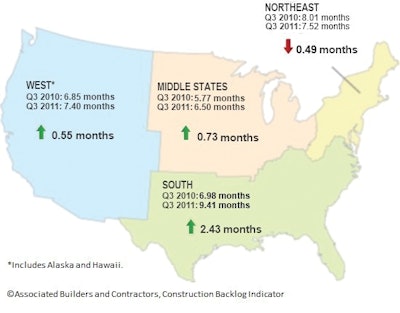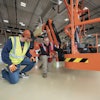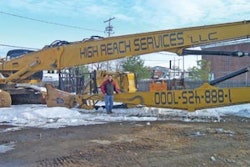
Associated Builders and Contractors (ABC) released its Construction Backlog Indicator (CBI) for the third quarter of 2011. At 8.1 months, the third quarter CBI remained unchanged from the previous quarter but was up 16.3 percent from a year ago. CBI is a forward-looking economic indicator that measures the amount of construction work under contract to be completed in the future.
"The lack of increase in the CBI last quarter appears to be a symptom of the soft patch in economic momentum experienced in the middle of this year, as well as the ongoing and elevated level of uncertainty regarding Europe, financial markets and other aspects of economic life," said ABC Chief Economist Anirban Basu.
"A backlog of less than 8 months is associated with construction spending declines, while a backlog exceeding 8 months is statistically associated with future construction spending increases," said Basu. "Today's level of backlog is consistent with flat construction spending."
"The implication of the most recent CBI data is that momentum in the U.S. nonresidential construction industry is in the process of stalling," said Basu. "The question remains: Will the nation's commercial and industrial construction industries face a long-term slump or become reinvigorated in the new year?"
Regional Highlights
- Regional construction backlog grew in the Northeast and the South from the second quarter to the third quarter, but shrank in the Middle States and the West. On a year-over-year basis, backlog is higher in every region of the nation with the exception of the Northeast.
- The South continues to report the lengthiest construction backlog of any major region at 9.41 months and is 35 percent higher than one year ago.
- Construction backlog in the Middle States continues to be the shortest at 6.5 months.
"One of the casualties of the economic soft patch was the level of growth in industrial production," said Basu. "This appears to have disproportionately impacted the Middle States region, which includes heavily industrial communities in Michigan, Ohio and Indiana. As a result, the relatively swift level of progress in renewed construction backlog experienced since the third quarter of 2010 in the Middle States has been at least temporarily halted.
"In contrast, even during the first half of the year when U.S. economic growth averaged less than 1 percent on an annualized basis, investment in the South – including in energy- and power-related industries in Texas, Oklahoma, and elsewhere in the region – continued to be brisk. Therefore, construction backlog in the South remains elevated relative to the balance of the nation and that is unlikely to change."
Industry Highlights
- Average construction backlog in the nation's infrastructure industry surged during the third quarter, with backlog expanding from 7.9 months a quarter ago to 9.2 months.
- In the commercial and institutional category, construction backlog took a step back, falling from 8.6 months during the second quarter to 8.4 months in the third quarter.
- Construction backlog rose in the heavy industrial category to 5.9 months during the third quarter, but is still down from year-ago levels and is lowest among all categories monitored by ABC.
"The biggest surprise in the data was the rebound in infrastructure construction backlog," said Basu. "During the second quarter, construction backlog in this category fell substantially, which was interpreted as a reflection of dwindling federal stimulus spending. However, during the third quarter, construction backlog bounced back neatly and is now at its highest level this year. For reasons that aren't entirely clear, there was a surge in government contracting in this category."
"In the commercial and industrial category, construction backlog is up 24 percent from the same time last year, a reflection of the rebound in consumer spending and general economic activity," Basu said. "Both anecdotal and survey data indicate lending conditions have become somewhat easier in the third quarter, which is consistent with a higher level of commercial construction starts."
Highlights by Company Size
- During the past quarter, firms in the $100 million or more category experienced the largest construction backlog at 9.8 months - the highest level for this category in the history of the CBI.
- For firms with annual revenues of less than $30 million, construction backlog declined from 7.5 months to 7.1 months.
- Construction backlog for firms in the $30 million to $50 million category saw a slight decrease from 9.8 months in the second quarter of this year to 9.7 months in the third quarter.
"It should be noted that well-placed, larger firms continue to enjoy the most predictable deal flow," said Basu. "Many of these larger firms are involved in the energy and power category, which has expanded faster in terms of construction spending during the past year than any other nonresidential construction segment. In contrast, the loss of construction backlog among smaller firms is consistent with recent data indicating many specialty trade contractors are now reducing staffing levels."



















